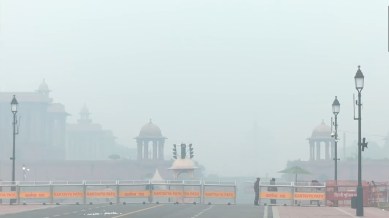Stay updated with the latest - Click here to follow us on Instagram
PM levels spike due to crackers, Delhi AQI ‘very poor’ post-Diwali
The AQI on Diwali day last year was 312, while it was 382 in 2021, 414 in 2020, 337 in 2019, and 281 in 2018. The AQI was 342 on Diwali day in 2015, 431 in 2016, and 319 in 2017.

PM10 and PM2.5 levels soared in several parts of the city Sunday night as firecrackers were set off in defiance of the ban.
Hourly PM10 levels were at 15 to 16 times the 24-hour standard at some stations. At the monitoring station at the Jawaharlal Nehru Stadium, the PM10 concentration peaked at 1632 µg/m3 at 2 am, when the 24-hour standard is 100 µg/m3. The level remained over 1000 µg/m3 from 11 pm to 4 am, falling to 467 µg/m3 by 8 am on Monday, going by data from the Delhi Pollution Control Committee (DPCC).
monthly limit of free stories.
with an Express account.
Similarly, hourly PM2.5 levels at the Jawaharlal Nehru Stadium were over 20 times the 24-hour standard Sunday night and early Monday morning. The PM2.5 concentration peaked at 1423 µg/m3 at 2 am, when the 24-hour standard is 60 µg/m3. The level had fallen to 383 µg/m3 by 8 am.
RK Puram saw a similar spike in pollution levels Sunday night. The PM10 concentration, which stood at 165 µg/m3 at 7 pm, shot up to 1380 µg/m3 at 11 pm. This has fallen to 405 µg/m3 by 8 am on Monday.
Delhi’s 24-hour average AQI deteriorated from what was a figure of 212 (in the ‘poor’ category) at 11 am on Sunday to 301 (in the ‘very poor’ category) at 10 am on Monday. The 24-hour average AQI at some monitoring stations was in the ‘very poor’ (301 to 400) category at 8 am Monday. At Jahangirpuri for instance, the AQI was 341, while it was 315 at Lodhi Road.
Winds and rainfall brought by a western disturbance last week had helped wash away pollutants that had accumulated in the city, keeping air quality levels in the ‘severe’ category. This also meant that the city recorded what was the best Diwali day air quality it has seen in eight years. The 24-hour average AQI at 4 pm on Sunday was 218, in the ‘poor’ category. The AQI on Diwali day last year was 312, while it was 382 in 2021, 414 in 2020, 337 in 2019, and 281 in 2018. The AQI was 342 on Diwali day in 2015, 431 in 2016, and 319 in 2017.